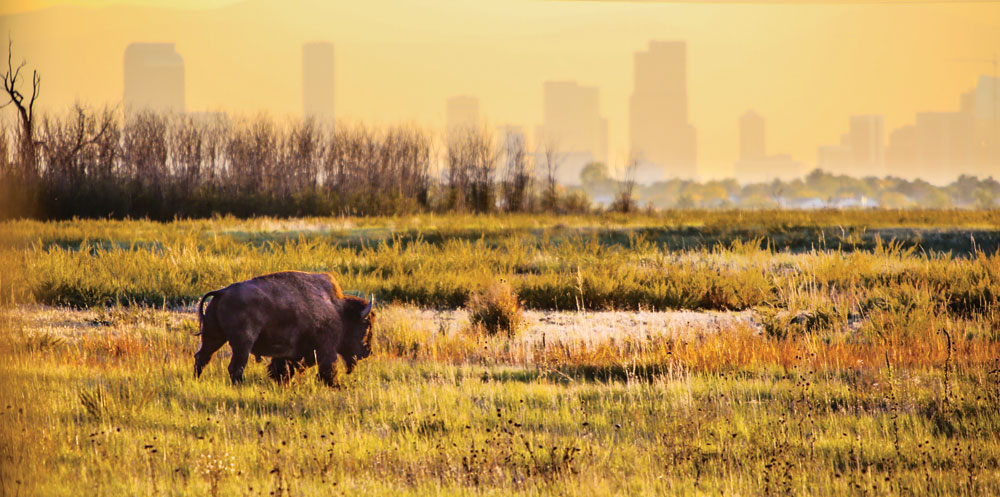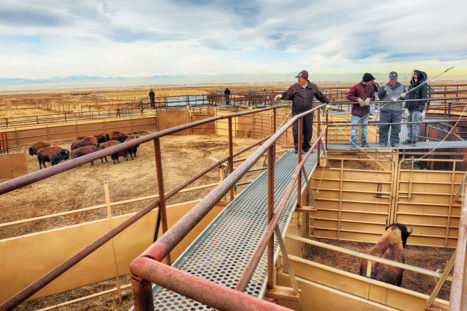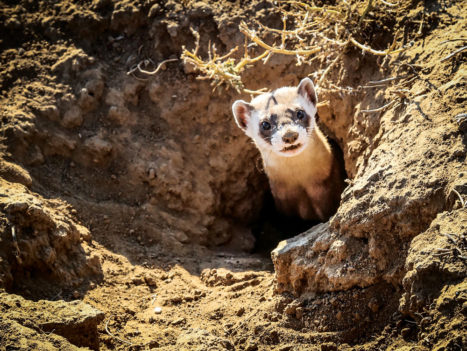
The bison roam free in the plains of the Refuge.
The Rocky Mountain Arsenal National Wildlife Refuge offers 15,000 acres of prairie, wetlands and woodlands that are home to a wide range of wildlife that includes bison and the endangered black-footed ferret.

If visitors are lucky, they might bison walking along the road right beside their car.
“Bison are an important part of plains ecology,” says Dave Lucas, manager at the Rocky Mountain Arsenal National Wildlife Refuge—and the public has great opportunities to visit the wildlife refuge and see these huge animals, weighing about 2,000 pounds each.
The refuge also boasts the world’s only indoor/outdoor black-footed ferret exhibit giving visitors a chance to observe the nation’s most endangered mammal. The reintroduction of black-footed ferrets is considered a success with the birth of babies at the refuge this year.
Bison Round-up

The Refuge has an annual bison round-up in December.
The bison are on the move during round-up time in December at the Wildlife Refuge. A yearly event, it provides an opportunity for staff to get an accurate count of the herd and assess the health of the animals. Calves are “chipped” to provide each animal with unique identification in much the same way our pets receive implanted microchips at the veterinarian’s office. In addition to disease surveillance, random hair and blood sampling provides genetic and antibody information about the animals.
The round-up also offers the chance to introduce new animals from one of the other seven refuge locations in the U.S. This year, 14 females and 11 males from Montana will join the Colorado herd. Selected for their rare, historic genes, they will enhance the existing herd in Colorado.
Lucas says the herd is treated in a “hands-off” manner to allow them to exist the way they would have years ago. Animals living in the wild are generally healthier and stronger than those in captivity and will breed and reproduce naturally. A reported plan to expand the bison habitat to include 200 acres of airport land along Peña Blvd. is still under discussion with no action planned at this time.
How about those endangered ferrets?

A ferret pokes its head out of a prairie dog hole on the day they were introduced to the Wildlife Refuge in October 2015.
Disease is problematic among rodent populations in the U.S. and at the Wildlife Refuge, so surveillance and mitigation efforts are undertaken as needed. Canine distemper is 100 percent fatal to wild animals and sylvatic plague can have a catastrophic effect on wild rodent populations. Historically, plague has been a problem for the prairie dogs at the arsenal.
Since ferrets eat prairie dogs, which can transmit lethal plague, young ferrets are captured for microchip implantation, vaccinations and the administration of an antibiotic. To ease the stress of being handled by humans, they are anesthetized during the procedures. To minimize the risk of disease and maintain the ferret’s food source, the Wildlife Refuge sprays prairie dog holes to kill fleas that carry plague.
In addition, prairie dogs at the Wildlife Refuge get an oral vaccine to protect them from plague. It is a blue, peanut butter-flavored pellet given in the fall when there is less vegetation for them to eat, making it more likely that the pellets will be eaten. Because the pellets turn the animal dung blue, Refuge staff can easily tell when it’s been eaten. Lucas points out that blue dung is an “especially fun fact” that school-aged children learn when they visit.
The refuge teaches respect for the animals and asks visitors to abide by the rules that protect both visitors and animals. “These are wild animals,” Lucas says. “If they sense danger, their fight-or-flight instincts kick in.”



0 Comments